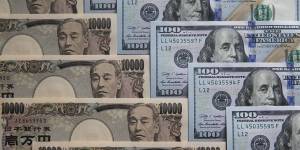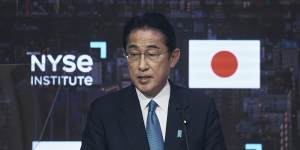The Japanese central bank’s decision to buy yen to prop up its value came after the yen broke through the 145 yen to the dollar level after depreciating about 20 per cent against the dollar this year.
The intervention worked,to a degree,with the exchange rate sliding back below 144 yen to the US dollar. The forces that had seen the yen plummet to its weakest levels against the US dollar since 1998,however,are if anything intensifying and therefore the intervention is a palliative,not a cure.

The safe-haven Japanese yen is sensitive to political turbulence.Bloomberg
Japan does have the foreign exchange reserves -- $US1.3 trillion ($A2 trillion) of them – to try to defend its currency,but the yen is the third most traded currency in the world,with turnover of about more than half a trillion dollars a day.
Sustained intervention is not a permanent response to the yen’s weakness nor do the Japanese authorities appear particularly interested in trying to reverse it,which would entail turning their backs on a decades-long effort to kickstart sustained economic growth.
The primary reason for the slump in the value of the yen is obvious. Until March this year,the yen had been trading within a relatively narrow band of 110 to 115 yen to the US dollar for years. In March,however,it started a rapid depreciation.
What happened in March? The US Federal Reserve Board began raising US rates from near-zero and has kept raising them at an aggressive pace. The federal funds rate is now targeting a range of 3 per cent to 3.25 per cent,with another 50 to 75 basis point increase expected at the Fed’s next Open Market Committee in November and more rate rises to come beyond that meeting.
The US 10-year government bond rate is now trading at yields of almost 3.7 per cent and two-year Treasury notes are yielding 4.2 per cent. By contrast,Japanese government 10-year bonds yield 0.22 per cent and its two-year securities minus 0.08 per cent.
In Japan’s case,the weakness of the yen is exacerbated by the nature of its monetary policies.
After the financial crisis in 2008,as the major central banks have embarked on zero or even negative policy rates and the large-scale quantitative easing programs (buying bonds and other securities) pioneered by Japan at the start of this century,the traditional “carry trade” between the yen and the dollar evaporated.
For nearly 20 years traders had borrowed cheaply in yen to invest in higher-yielding assets elsewhere – US Treasuries were the near risk-free trade – and picked up a very tidy yield and income differential in the process. When all the central banks were at or near zero – as Japan has been since 1999 – that trade disappeared.
When the Fed started raising US rates in March,however,borrowing yen to buy US bonds became an increasing attractive trade,one made even more compelling by the likelihood that the yen would continue to weaken against the dollar as US rates continued to rise and therefore add currency gains to the interest rate differential.
To some degree,the relationship between a weakening yen/strengthening US dollar is mirrored around the world because the Fed is now out-pacing even the more hawkish central banks in tightening its monetary policies.
The Australian dollar has,for instance,was trading at just under US76 cents in March. Despite five Reserve Bank rate hikes that have taken the cash rate from near zero to 2.35 per cent,it is now trading at just above US65 cents.
In Japan’s case,the weakness of the yen is exacerbated by the nature of its monetary policies.
Unlike the other central banks it is not tightening its policies and remains committed to heavy interventions in bond and even equity markets to keep its interest rates and equity premia ultra-low. It uses those interventions and yield curve control to impose a 0.25 per cent cap on 10-year bond rates while keeping short-term rates below zero to try to put a floor under economic activity.
Its policies have resulted in the Bank of Japan (BoJ) owning more than half the government bond market and a majority of the equity in Japan’s exchange-traded equity funds.
With the central bank and the powerful Ministry of Finance committed to maintaining the current monetary policies,that implies a widening gap between Japan’s interest rates and those of the rest of the developed world and the US in particular.
Japan doesn’t face quite the same pressure to raise rates as the Fed,or RBA or many of their peers. Unlike the US,Europe or Australia,inflation isn’t a major challenge for Japanese policymakers. In August,it was running at 2.8 per cent. If energy and food were excluded it was 1.6 per cent.

Prime Minister of Japan Fumio Kishida.AP
While a weaker currency will impact the cost of key imported products like energy and food,for a country that has been obsessed with deflation,not inflation,for the past three decades the current inflation levels aren’t unsettling and,to some extent,are even welcome.
Apart from its monetary policy settings,the other factors driving yen weakness are the country’s trade and current account deficits,which have blown out largely because of the steep increases (and Japan’s heavy dependence) on energy and food imports. A record trade deficit means a lot of yen being deployed in global markets to pay for those imports.
While the BoJ doesn’t appear to be overly stressed by the re-emergence of carry trades based on the yen,along with record levels of shorting of its currency,that might change if Japanese retailer traders – the generically-labelled “Mrs Watanabe” housewives who control the family savings – started to shift their vast hoards of deposits into global markets.
With more than 1000 trillion yen (close to $US8 trillion) of cash and term deposits and some history,back in the 1980s,of chasing offshore returns,there is some prospect of flood of domestic capital fleeing Japan and exacerbating the pressure on the currency.
The Bank of Japan’s intervention in currency markets was to try to dampen the volatility rather than reverse the direction of the yen. It might also have wanted to remind traders and domestic savers that the yen-for dollars trade isn’t necessarily a one-way street.
Currency depreciation might help exporters but,having offshore a lot of manufacturing activity in recent decades,that volatility presents a threat to the stability of domestic companies. Even if it can’t prevent the yen from being further devalued,the BoJ would want to slow and smooth its path.
Ultimately,the only way for the Japanese authorities to reverse the current trend is to narrow the interest rate differentials with the other major economies by raising their own rates.
That would require strong evidence of an economic resurgence that Japan has been searching for – so far without any real success -- with its range of extraordinary monetary and ultra-expansive fiscal policies for more than 30 years.
The Business Briefing newsletter delivers major stories,exclusive coverage and expert opinion..